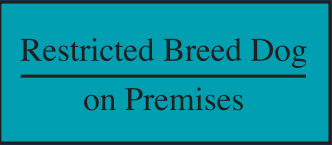Part 4 of series examining proposed changes to Victoria’s Domestic Animals Act
Legislating against Scary Looking Dogs
Breed Specific Legislation has never been shown to reduce the incidence of dog bites anywhere it’s been tried. While many Governments are reviewing or abandoning this failed approach, John Brumby’s Government has just enacted a range of measures to further crack down on “pit bulls”.
Previous Laws Restricted Owners Of Pit Bulls
Victoria already had strict regulations for the ownership of Restricted Breed Dogs (aka. American Pit Bull Terriers). Owners were required to notify their council, keep them in a child proof enclosure, keep their dogs muzzled and on a lead when off their property and display prescribed warning signs at all entrances to the premises where the dog is kept. Restricted breed dogs born after 2005 were not allowed to be registered.
Can you identify the Pit Bull?
The problem was, Council rangers were mistakenly declaring crossbred dogs as American Pit Bull Terriers. This would lead to much anguish for families as dogs were seized and held. In some cases, owners appealed and were given their dogs back. We are sure there are many others who were not so fortunately. The thing is, you can’t determine that a dog is a purebred American Pit Bull Terrier from appearance alone. You need to know the ancestry of the dog.
Try for yourself! Click on the pictures below to find the Pit Bull.

1 |

2 |

3 |

4 |

5 |

6 |

7 |

8 |

9 |

10 |

11 |

12 |

13 |

14 |

15 |

16 |

17 |

18 |

19 |

20 |

21 |

22 |

23 |

24 |

25 |
Neither Can The “Experts”
“The determination of whether a dog is of a particular breed can be quite difficult. There is, on the evidence before me, no satisfactory scientific method such as DNA analysis which provides a reliable answer. The word “breed” itself has to be applied carefully. To determine whether a dog is of a particular breed is, of course, a question of fact.”
Victoria now Legislates Based on Appearance, Not Breed
To avoid costly court challenges over the validity of visual breed identifications, the the newly amended Bill deems the actual breed of the dog irrelevant.
“The Bill provides for a standard to be prescribed to assist with the identification of a dog as one of the restricted breed dogs. If a dog fits within the standard it will be included in the definition of a restricted breed dog whether or not the dog is a cross breed.”
– Domestic Animals Amendment (Dangerous Dogs) Bill 2010 : Second Reading Speech
A dog of any breed, even a pedigree, could potentially fall within the prescribed standard for Pit Bulls. A Department of Primary Industries spokesperson confirmed that the prescribed standard for Pit Bulls does not exist. He stated that the DPI would create one after the Bill is enacted. The 2006 Edition of the DPI’s “Guidleines for Identification” are farcical. As a ranger explained at a recent Review Panel hearing “My German Short Haired Pointer is a Pit Bull according to those guidelines”.
Rethinking Dangerous Dogs
Breed Specific Legislation has been tried around the world and has failed to reduce the incidence of dog bites. Experts are calling for a rethink on dangerous dogs with a focus on “deed not breed”.
“We know that a dog’s tendency to bite is the product of at least five factors: the dog’s genetic predisposition to aggression; early socialisation to humans; its training or mistraining; the quality of its care and supervision; and the behaviour of the victim. Genetics is only one of these factors. In the wrong circumstances, any dog, regardless of size, breed or mixture of breeds can be dangerous. The RSPCA believes that deeming a dog as “dangerous” should therefore be done on the basis of its behaviour, not its breed.”
The Scottish Parliament recently passed a Bill that shifted the emphasis from ‘breed’ to ‘deed’.
“It is clear that a dog’s breed is only one factor which may affect its behaviour. Attempting to define the law purely in relation to breed has failed to protect the public. This view is supported by several leading organisations concerned with the welfare of dogs, including the Kennel Club, Advocates for Animals, the Dogs Trust and the Scottish Society for the Prevention of Cruelty Problems with existing legislation to Animals. The widely accepted view is that the way a dog is trained and treated is far more important in determining its behaviour than its breed is.”
The British Government is preparing a review of its Dangerous Dogs legislation
“The BVA believes that the manner in which a dog behaves is largely a result of its inherited characteristics, but more importantly the rearing and training provided by the owner.
The BVA has therefore long been opposed in principle to any proposal or legislation that singles out particular breeds of dogs rather than targeting individual aggressive dogs. The problems caused by dangerous dogs will never be solved until dog owners appreciate that they are responsible for the actions of their animals. This is known as the ‘deed not breed’ principle.”
Pit Bull Hoax Video
Containing interviews from world renowned dog experts such as Ian Dubbar, Pit Bull Hoax exposes the failure of Breed Specific Legislation to reduce the incidence of dog bites. It provides a reasoned counterpoint to the pit bull hysteria promoted by the media and politicians. This video is made available with kind permission of Drayton Michaels at PitBullGuru.com
What Makes More Sense
The definition of Restricted Breed should not be extended to include dogs of any breed who happen to look like someone’s idea of a Pit Bull. Responsible owners of well behaved dogs should not have to worry that their dog might be declared a restricted dog simply because of the way it looks.
Perhaps it’s time to stop pandering to media generated hysteria over Pit Bulls and accept that BSL is an overly simplistic response to the problem of dog bites and that our efforts would be better spent on other approaches.



